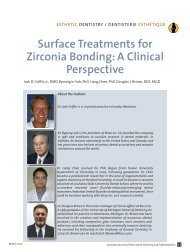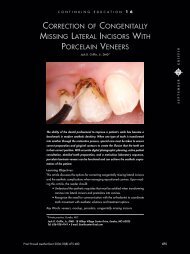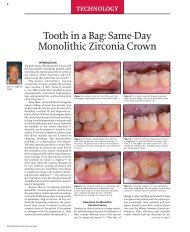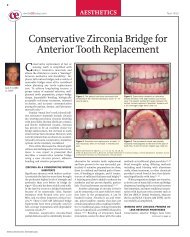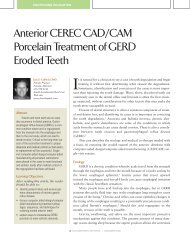Efficient Correction of Endodontic Obturation and Single-Appointment
Efficient Correction of Endodontic Obturation and Single-Appointment
Efficient Correction of Endodontic Obturation and Single-Appointment
- No tags were found...
Create successful ePaper yourself
Turn your PDF publications into a flip-book with our unique Google optimized e-Paper software.
Practical Procedures & AESTHETIC DENTISTRYFigure 7. Proposed CAD design <strong>of</strong> the all-ceramic crownfor the first premolar. Very little adjustments would berequired for contouring or occlusion.Figure 8. Excess gutta-percha <strong>and</strong> periapical granulationtissues were removed. Class I 3-mm– to 4-mm–deep retrogradepreparations were then made.tional occlusion, the “correlation” design mode <strong>of</strong> theCEREC 3D (Sirona Dental Systems, Charlotte, NC) waschosen. This mode would allow the CAD/CAM systems<strong>of</strong>tware to closely copy the occlusal anatomy <strong>and</strong> some<strong>of</strong> the facial <strong>and</strong> lingual surfaces, which would minimizeocclusal adjustments after fabrication (Figure 3). Whilewaiting for the anesthesia to take effect, the author applieda glycerin-based powder adhesive <strong>and</strong> a titanium dioxidereflective medium from canine to molar in the affectedquadrant. Three images were captured by the CAD/CAMsystem to provide adequate information to copy theanatomy <strong>of</strong> the unprepared teeth.A caries indicator was applied to dry teeth severaltimes, <strong>and</strong> all decay was removed using various burs. Thedefects were filled with a flowable composite resin (ie,Flow-It ALC, Pentron Corporation, Wallingford, CT). Uponaccess, the existing gold screw posts were found to besecure <strong>and</strong> deemed to be clinically sound. The decay onthe distal aspect <strong>of</strong> the second premolar extended 3 mmsubgingivally <strong>and</strong> was incorporated into the preparation.A minimum <strong>of</strong> 2 mm <strong>of</strong> occlusal clearance in allexcursive movements was prepared to provide adequateporcelain thickness <strong>and</strong> to reduce the potential <strong>of</strong>fracture (Figure 4). Using a series <strong>of</strong> course diamondburs, tooth reduction was performed. All internal lineangles were rounded slightly to help decrease stresseswithin the porcelain. Margins were finished with anend-cutting diamond to provide a 1.5-mm rounded shoulderfor strength <strong>and</strong> to facilitate recording <strong>of</strong> the marginby the CAD/CAM system. The prepared teeth wererecoated with the same adhesive <strong>and</strong> titanium dioxidepowder. Three images were captured by the CAD/CAMsystem, <strong>and</strong> a digital, three-dimensional model was created(Figure 5). The design was started with the trimming<strong>of</strong> the digital dies to ease in the porcelain design. Byusing the design features <strong>of</strong> the CAD/CAM system’s correlationmode, the preoperative occlusal data wereFigure 9. The MTA was placed into the retrograde preparations,<strong>and</strong> blood was allowed to pool around the MTA tohelp ensure set <strong>of</strong> the material.copied into the design (Figure 6). The computer proposeda design that corrected the slight rotation <strong>of</strong> thetooth (Figure 7).The CAD/CAM system can process several porcelainmaterials (eg, Vita Mark II, Vident, Brea, CA;ProCAD, Ivoclar Vivadent, Amherst, NY) that can bestained <strong>and</strong> glazed <strong>and</strong> have the strength to function infull-coverage crown restorations. 13,14 The CAD designwas finished in about 3 minutes <strong>and</strong> sent to the millingunit for the fabrication <strong>of</strong> the all-ceramic restoration.Because the entire preoperative was acquired in theCAD/CAM system, a second powdering <strong>and</strong> acquisitionwas not necessary. This increases efficiency as bothcrowns can be prepared <strong>and</strong> designed with one preoperativeimage <strong>and</strong> one postpreparation image. Thecrown being milled for the first premolar was placed onthe model as a “virtual” crown so that the design couldbe rendered for the adjacent tooth. While milling wascompleted for the first premolar, the second was designedusing the same principles. It was milled after milling <strong>of</strong>the first crown was completed.572 Vol. 17, No. 8
GriffinFigure 10. Occlusion was verified so that the crowns wereslightly out <strong>of</strong> contact. Basic anatomical occlusal grooveswere then slightly accentuated with a finishing diamond bur.Figure 12. At 6 weeks posttreatment, healing was acceptable<strong>and</strong> the patient had elimination <strong>of</strong> biting pain. Thedefinitive all-ceramic crown restorations provide naturalfunction <strong>and</strong> aesthetics.materials. 16,17 The apical preparations are dried, the materialplaced, <strong>and</strong> then moisture was allowed near it t<strong>of</strong>acilitate setting.Figure 11. Radiograph taken immediately postoperation.Surgical <strong>Endodontic</strong>sBecause the total milling time for restorations <strong>of</strong> both teethwas approximately 35 minutes, the apical correctionwas accomplished during that time. A full-thickness flapwas made across the attached tissue, <strong>and</strong> releasing incisionswere made to widen the base <strong>of</strong> the incision; aperiosteal elevator was used to fully reflect the tissue.Gutta-percha overfills <strong>of</strong> almost 6 mm were obvious afterthe reflection <strong>of</strong> s<strong>of</strong>t tissue in two roots on tooth #5 <strong>and</strong>one root on tooth #4.The end <strong>of</strong> the roots were reduced, rounded, <strong>and</strong>inspected for fractures. A 3-mm–deep Class I preparationwas made into the roots along the path <strong>of</strong> the guttapercha(Figure 8). In comparison to a shallower design,deeper preparations would provide a better apical sealagainst bacterial invasion. 15 All granulation tissue wasremoved by curettes <strong>and</strong> mineral trioxide aggregate (ie,ProRoot MTA, Dentsply Tulsa, Tulsa, OK) was mixed withsterile saline into a thick paste <strong>and</strong> placed into the rootpreparations (Figure 9). Placement <strong>of</strong> the MTA wouldresult in less apical leakage than other retrograde fillingPorcelain Try-In, Adjustment, <strong>and</strong> CustomizationThe surgical site was covered with gauze <strong>and</strong> bothcrowns were tried in while the MTA was setting. The marginswere verified <strong>and</strong> occlusion was checked <strong>and</strong>adjusted with an extra-fine finishing diamond bur <strong>and</strong>irrigation (Figure 10). Since there was the possibility <strong>of</strong>supereruption from surgical inflammation, the teeth wereleft slightly out <strong>of</strong> occlusion. Final contours were finished<strong>and</strong> the crowns were removed.The porcelain was rinsed <strong>and</strong> cleansed with alcoholto prepare for customization. Stains (ie, Vita Akzent,Vident, Brea, CA) <strong>and</strong> glaze were applied to bothcrowns to achieve better color match <strong>and</strong> a smooth surfaceto increase strength, feel for the patient, <strong>and</strong> toreduce abrasiveness for the opposing occlusion. 18 A singlebake was accomplished in a porcelain oven forapproximately 20 minutes, <strong>and</strong> then both were benchcooled. In that time, 4-0 chromic gut sutures were usedto reapproximate the tissue after excess MTA was cleanedfrom around the apices.The all-ceramic crowns were then etched with hydr<strong>of</strong>luoricacid for 2 minutes, <strong>and</strong> silane was applied for5 seconds. The crowns were cemented with a hybridcomposite (ie, RelyX Unicem, 3M Espe, St. Paul, MN)<strong>and</strong> a dual-cured cement with excellent h<strong>and</strong>ling <strong>and</strong>wear characteristics. 19 The cement was cured for 5 seconds,at which time the crowns were flossed <strong>and</strong> excesscement was removed with a 204s scaler. The crownswere then light cured for 20 seconds from three surfaces(Figures 11), <strong>and</strong> postoperative instructions were givento the patient.Follow-up was done 3 weeks later when thePPAD 573
Practical Procedures & AESTHETIC DENTISTRYthe function <strong>of</strong> the crowns <strong>and</strong> the s<strong>of</strong>t tissue response wasacceptable (Figure 15).Figure 13. More than 26 months following treatment,the anatomy <strong>and</strong> function <strong>of</strong> the restorations were clinicallysuccessful.ConclusionThe clinician must be confident in the endodonticcorrection before final cementation <strong>of</strong> the all-ceramicrestorations. If the apical correction had been insufficient,the patient would have been appointed for a subsequentvisit or referral to an endodontist, <strong>and</strong> the patient wouldhave been provisionalized instead <strong>of</strong> receiving the definitivecrowns. In the case presented herein (despite previousendodontic failure <strong>and</strong> less-than-ideal postendodonticrestorations) successful correction was achieved usingtechniques supported by the scientific literature. In oneappointment, long-lasting, aesthetic, <strong>and</strong> healthpromotingtreatment was rendered, giving value to thepatient <strong>and</strong> efficiency to the <strong>of</strong>fice.Figure 14. Radiograph at 32 months demonstrated apicalhealing with the absence <strong>of</strong> pathology.Figure 15. At nearly 3 years, healing is complete <strong>and</strong> thepatient is asymptomatic. Aesthetic <strong>and</strong> functional servicewith excellent s<strong>of</strong>t tissue response has been achieved.gingival tissues were healing well but were still slightlyinflamed. At 6 weeks, healing was excellent <strong>and</strong> the patientcould function comfortably on the definitive restorations(Figure 12). There was no return <strong>of</strong> a fistula or pain at the26-month examination, <strong>and</strong> tissues were healthy with nopatient complaints (Figure 13). At nearly 3 years postoperation,radiographs show a lack <strong>of</strong> periapical pathology(Figure 14); the patient had no clinical symptoms <strong>and</strong>References1. Nagasir R, Chitmongkolsuk S. Long-term survival <strong>of</strong> endodonticallytreated molars without crown coverage: A retrospective cohort study.J Prosthet Dent 2005;93(2):164-170.2. Aquilino SA, Caplan DJ. Relationship between crown placement <strong>and</strong>the survival <strong>of</strong> endodontically treated teeth. J Prosthet Dent2002;87(3):256-263.3. Ray HA, Trope M. Periapical status <strong>of</strong> endodontically treated teethin relation to the technical quality <strong>of</strong> the root filling <strong>and</strong> the coronalrestoration. Int Endod J 1995;28(1):12-18.4. Krakow AA, de Stoppelaar JD, Gron P. In vivo study <strong>of</strong> temporaryfilling materials used in endodontics in anterior teeth. Oral SurgOral Med Oral Pathol 1977;43(4):615-620.5. Lynch CD, Burke FM, Ni Riordain R, Hannigan A. The influence <strong>of</strong>coronal restoration type on the survival <strong>of</strong> endodontically treated teeth.Eur J Prosthodont Rest Dent 2004;12(4):171-176.6. Clinical Research Associates Newsletter. Products highly rated byCRA evaluators in clinical field trials, but not reported previously inthe CRA newsletter. CRA Newsletter 1995;19(2):1-4.7. Carrotte P. Surgical endodontics. Br Dent J 2005;198(2):71-79.8. Naoum HJ, Ch<strong>and</strong>ler NP. Temporization for endodontics. Int EndodJ;35(12):964-978.9. Bishop K, Briggs P. <strong>Endodontic</strong> failure–-A problem from top to bottom.Br Dent J 1995;179(1):35-36.10. Balto H. An assessment <strong>of</strong> microbial coronal leakage <strong>of</strong> temporaryfilling materials in endodontically treated teeth. J Endod 2002;28(11):762-764.11. Heling I, Gorfil C, Slutzky H, et al. <strong>Endodontic</strong> failure caused byinadequate restorative procedures: Review <strong>and</strong> treatment recommendations.J Prosthet Dent 2002;87(6):674-678.12. CEREC Symposium 2001. Compend Contin Educ Dent (Suppl)2001;22.13. Fasbinder DJ. Restorative material options for CAD/CAM restorations.Compend Contin Educ Dent 2002;23(10):911-920.14. Gaglio MA. Esthetic restorations designed with confidence <strong>and</strong> predictability.Compend Contin Educ Dent 2001;22 (Suppl 6);30-34.15. Al-Kahtani A, Shostad S, Schifferle R, Bhambhani S. In-vitro evaluation<strong>of</strong> microleakage <strong>of</strong> an orthograde apical plug <strong>of</strong> mineral trioxideaggregate in permanent teeth with simulated immature apices. JEndod 2005;31(2):117-119.16. Fischer EJ, Arens DE, Miller CH. Bacterial leakage <strong>of</strong> mineral trioxideaggregate as compared with zinc-free amalgam, intermediaterestorative material, <strong>and</strong> Super-EBA as a root-end filling material. JEndod 1998;24(3):176-179.17. Martell B, Ch<strong>and</strong>ler NP. Electrical <strong>and</strong> dye leakage comparison <strong>of</strong>three root-end restorative materials. Quint Int 2002;33(1):30-34.18. Fischer H, Brehme M, Telle R, Marx R. Effect <strong>of</strong> ion exchange <strong>of</strong>glazed dental glass ceramics on strength parameters. J Biomed MaterRes A 2005;72(2):175-179.19. Reality 2005. Houston, TX: Reality Publishing Company. 2005;19:1004-1006.574 Vol. 17, No. 8
CONTINUING EDUCATION(CE) EXERCISE NO. 2020CONTINUING CEEDUCATIONTo submit your CE Exercise answers, please use the answer sheet found within the CE Editorial Section <strong>of</strong> this issue <strong>and</strong> complete as follows:1) Identify the article; 2) Place an X in the appropriate box for each question <strong>of</strong> each exercise; 3) Clip answer sheet from the page <strong>and</strong> mailit to the CE Department at Montage Media Corporation. For further instructions, please refer to the CE Editorial Section.The 10 multiple-choice questions for this Continuing Education (CE) exercise are based on the article, “<strong>Efficient</strong> correction <strong>of</strong> endodonticobturation <strong>and</strong> single-appointment CAD/CAM restoration,” by Jack D. Griffin, Jr., DMD, FAGD, PC. This article is on pages 569-574.1. <strong>Endodontic</strong> failure can be caused by which <strong>of</strong> thefollowing factors?a. Improper diagnosis.b. Poor obturation.c. Poor coronal restoration.d. All <strong>of</strong> the above.2. Which <strong>of</strong> the following is the most true in terms <strong>of</strong>relationship between quality coronal restorations <strong>and</strong>long-term clinical endodontic success?a. Temporaries can be left in the access indefinitely.b. Complete, nonleaking coronal coverage increased thechances <strong>of</strong> endodontic success.c. Thorough diagnosis, canal cleansing, <strong>and</strong> obturationyield dependable long-term success regardless <strong>of</strong> coronaltherapy.d. <strong>Endodontic</strong> success <strong>and</strong> restorative therapy are notrelated.3. A retrograde material with proven microleakage controlthat is mixed with saline <strong>and</strong> placed in a moist field tostimulate material set is:a. EBA.b. IRM.c. Amalgam.d. MTA.4. Which <strong>of</strong> the following retrograde preparations gives theleast bacterial infiltration?a. 1 mm to 2 mm deep.b. 3 mm to 4 mm deep.c. 5 mm deep or more.d. None <strong>of</strong> the above.5. Before cementing the definitive restorations on the sameappointment as the endodontic therapy, the clinicianshould:a. Have clinical experience <strong>and</strong> confidence in the outcome<strong>of</strong> the endodontic therapy.b. Make sure the patient has paid in full.c. Explain to the patient that the restorations should last alifetime <strong>and</strong> should be problem-free.d. Make sure the teeth are in hyperocclusion to preventtheir supereruption.6. Which <strong>of</strong> the following is an advantage <strong>of</strong> singleappointment,<strong>of</strong>fice-made porcelain restorations?a. Better coronal seal from secondary bacterial invasionwhen compared to temporary restorations.b. Fewer appointments with less manipulation <strong>of</strong> tissues<strong>and</strong> reduced chances <strong>of</strong> iatrogenic problems.c. Quality fit, aesthetics, <strong>and</strong> function without impressions,temporaries, <strong>and</strong> additional appointments.d. All <strong>of</strong> the above.7. Which <strong>of</strong> the following is NOT a true statement?a. There is evidence that suggests that a quality, nonleakingcoronal restoration may be at least as important asa quality obturation.b. Temporary restorations have no effect on leakage or thesuccess <strong>of</strong> endodontic therapy.c. Long-term temporary restorations yield higher endodonticfailure rates than those with definitive restorations placed.d. <strong>Endodontic</strong> survival rates were higher in teeth withcrowns placed within 1 year <strong>of</strong> treatment over thosewith crowns placed at 5 years.8. The preparation characteristics for CEREC crowns aresimilar to other all-porcelain systems in many ways.Which <strong>of</strong> the following is a way in which they differ?a. Feather-edged margins.b. Well-defined chamfer or shoulder margins.c. A minimum <strong>of</strong> 1.5 mm <strong>of</strong> occlusal clearance.d. Rounded, internal line angles.9. A CAD/CAM mode that copies the occlusal morphology<strong>and</strong> some buccal <strong>and</strong> lingual anatomy <strong>and</strong> incorporatesthem into the milled restoration is:a. Function.b. Dental database.c. Correlation.d. Constipation.10. Which <strong>of</strong> the following is NOT an advantage <strong>of</strong> using aself-etch composite cement?a. The tooth needs to be desiccated before cementation.b. No etch is necessary.c. Separate bonding agents are not needed.d. They may be used with all porcelain crowns.576 Vol. 17, No. 8



